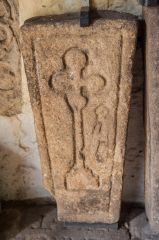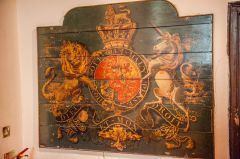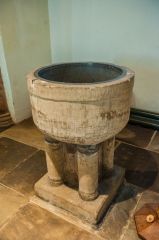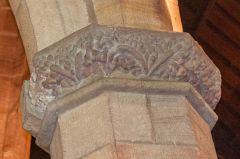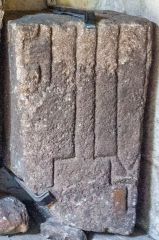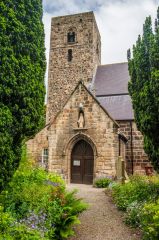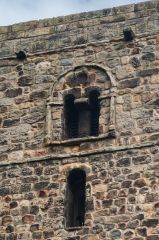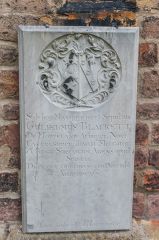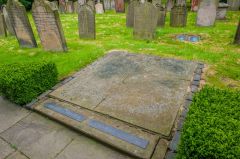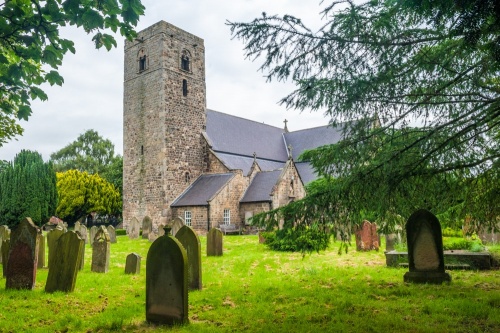
St Mary the Virgin Church in Ovingham is a late Saxon building with a 12th-century porch. The church was rebuilt in the 13th century and restored in the Victorian period. The name 'Ovingham' suggests the parish's ancient origins. The name comes from Old English meaning 'homestead of Offa's sons'.
The oldest part of the building is the tower, which is largely a product of the 11th century, but there is thought to have been a much earlier church on the site. Some of the stones set into the tower base are thought to have come from nearby Roman sites.
There are also 12th-century lancet windows in the east wall. In the churchyard is the grave of Thomas Bewick, a famous 19th-century artist, who was born in the village. The gravestones of Bewick and his wife Isabella have been moved inside the porch for safekeeping. Their actual burial place is marked with a pair of metal plaques. Bewick's birthplace at nearby Cherryburn is now preserved by the National Trust.
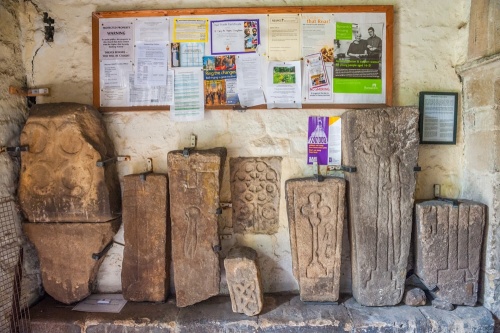
The Defiant Abbot
It is hard to imagine it, seeing how peaceful Ovingham is today, but in 1534 St Mary's Church was the setting for a deadly act of defiance and death. As part of his Dissolution of the Monasteries, Henry VIII sent church commissioners to dissolve Hexham Abbey.
The Abbot of Hexham was not one to let Henry's efforts go unchallenged. He dressed in armour and climbed to the top of St Mary's tower where he challenged the church commissioners. It may have been an act of conscience but it was a futile one, for the Abbot was executed by hanging, ostensibly for the act of wearing armour, which was forbidden to a cleric.
The Medieval Cross Slabs
One of the historical highlights at Ovingham is a collection of medieval cross-slabs in the porch. There are 7 slabs, dating from the late 11th to the 14th century. One unusual fragment of a slab shows a carved sword blade and a key, the traditional male and female symbols.
Presumably, the symbols represent a husband and wife but it is extremely rare to find both symbols together on the same grave slab. Other grave slabs show floriated crosses and shears.
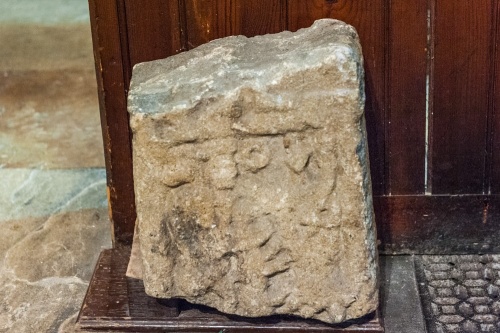
In addition to the medieval slabs, there is a piece of a free-standing Saxon cross. Another fragment of a Saxon cross dating to the late 10th century lies beneath the pulpit. One face of the latter cross depicts a figure with an exaggerated oval head, while on the reverse is a hunting scene.
The doorway is a very simple Norman design with plainly carved rounded arches. Just inside the door is a royal coat of arms painted on a wooden panel. It isn't immediately clear when the coat of arms was painted as there are no obvious royal initials.
At the west end of the north aisle is a simple 13th-century font in tub shape supported on clustered pillars.
In the chancel is a trefoiled double sedilia dating to the 14th century and there are several finely carved medieval column capitals in the nave. It is well worth walking around the outside of the church to see several very good gravestones set against the wall, including one to William Blackett, who died in 1695.
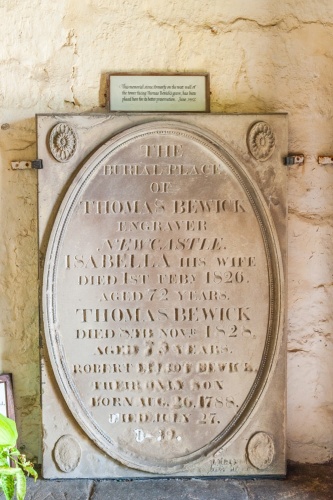
Opposite the churchyard in The Hill is the 'Goose Fair Cross', an 11th-century cross head on a modern shaft and base. The Goose Fair itself dates to the 13th century when farmers walked geese from the Carlisle region to markets in Newcastle and Gateshead. The Goose Fair is now a simple village fair held on the 3rd Saturday in June.
Getting There
The church is extremely easy to find. It is located just over Ovingham Bridge from Prudhoe, at the junction of Main Road and West Road. The church is usually open to visitors and was open when we visited.
About Ovingham, St Mary's Church
Address: The Hill,
Ovingham,
Northumberland,
England, NE42 6AB
Attraction Type: Historic Church
Location: Just over the Ovingham Bridge from Prudhoe at the junction of Main Road and West Road.
Website: Ovingham, St Mary's Church
Location
map
OS: NZ085637
Photo Credit: David Ross and Britain Express
HERITAGE
 We've 'tagged' this attraction information to help you find related historic attractions and learn more about major time periods mentioned.
We've 'tagged' this attraction information to help you find related historic attractions and learn more about major time periods mentioned.
Find other attractions tagged with:
NEARBY HISTORIC ATTRACTIONS
Heritage Rated from 1- 5 (low to exceptional) on historic interest
Prudhoe Castle - 0.6 miles (Castle) ![]()
Cherryburn - 0.9 miles (Historic Building) ![]()
Bywell Castle - 2.5 miles (Castle) ![]()
Bywell, St Andrew's Church - 2.6 miles (Historic Church) ![]()
Bywell, St Peter's Church - 2.6 miles (Historic Church) ![]()
George Stephenson's Birthplace - 2.7 miles (Historic Building) ![]()
Bywell Hall - 2.7 miles (Historic House) ![]()
Heddon-on-the-Wall (Hadrians Wall) - 3.8 miles (Roman Site) ![]()
Nearest Holiday Cottages to Ovingham, St Mary's Church:
Heddon-on-the-Wall, Northumberland
Sleeps: 4
Stay from: £411 - 1871
More self catering near Ovingham, St Mary's Church
